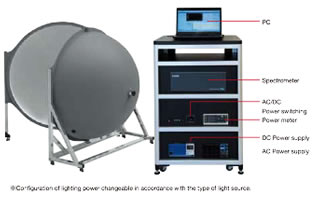

This system enables the total luminous flux measurement of luminous intensity distribution 2 and 4 light sources based on the measurement standards of LED lightings LM-78 and LM-79 approved by IESNA (Illuminating Engineering society of North America) .
As a calibration function, it can do the self-absorption correction and the spectral intensity calibration based on the JIS C 8152 measurement methods.
Total Luminous Flux Measurement System
This system enables the high quality total luminous flux measurement for light sources such as LED lights, back light and Organic Electro Luminescence.
Overview
This system enables the total luminous flux measurement of luminous intensity distribution 2 and 4 light sources based on the measure- ment standards of LED lightings LM-78 and LM-79 approved by IESNA (Illuminating Engineering society of North America) .
As a calibration function, it can do the self-absorption correction and the spectral intensity calibration based on the JIS C 8152 measure- ment methods.
Features
- Various size is available (From 2inch to 3m(120inch))
- It realizes the long stable measurement by using a high weather-resistant material for the internal surface of integrating sphere.
- Up to 100,000lm light source measurement is capable. 「A satellite type integrating sphere can be connected to the measurement port.」 「As for a detector, you can select from a coolant type BT-CCD and a high D range type NMOS.」
- All types of light source can be measured by changing fixtures and sockets.
- A standard LED transposition holder can be installed.
- It conducts the total luminous measurement by auto controlling a light source power supply, a wattmeter and a spectrometer.
- It includes a self-absorption correction function.
- It includes the wavelength axis calibration and spectral sensitivity calibration functions.
- It includes the specific-purpose software in Japanese, English and Chinese.
Practice screen

Basic Composition

- Integrating sphere/li>
- Spectrometer
- NIST standard calibration light source
- Self-absorption correction lamp
- Low pressure mercury lamp
- DC generator (AC generator and wattmeter is available)
- Specific-purpose software
System Structure
It is divided into 2 measurement and 4 measurement based on the light distribution characteristics of measurement light source. A light source such as a light bulb emitting in all directions uses 4 measure- ment which put it in the middle of an integrating sphere for measure- ment. A light source such as a spot light emitting in the front direction uses 2 measurement which put it outside of an integrating sphere for measurement.
MEASUREMENT FUNCTION
- 1)Occasional Measurement Function
- 2)Successive Measurement Function
It can conduct the successive measurement to consolidate the operating progress condition for quality control and research. It also includes the measurement report display and print-out function as well as CSV files output function and spectral analysis, chromaticity coordinates analysis and color rendering index analysis in graph in addition with a measurement condition set-up function for efficient measurement.
Measurement Items
- Total Luminous Flux(LF [lm])
- Radiant Flux(RF[W])
- Luminous Efficiency(LE[lm/W])
- Chromaticity(CIE x, y), (CIE u, v), (CIE u ́, v ́)
- Correlated Color Temperature (Tcp[K])
- Blackbody Radiation Locus Deviation(Duv)
- Color Rendering Index(CRI)
- Spectral Radiant Intensity Spectral([W/nm])
- Dominant wavelength, each peak information (Half width) & etc




